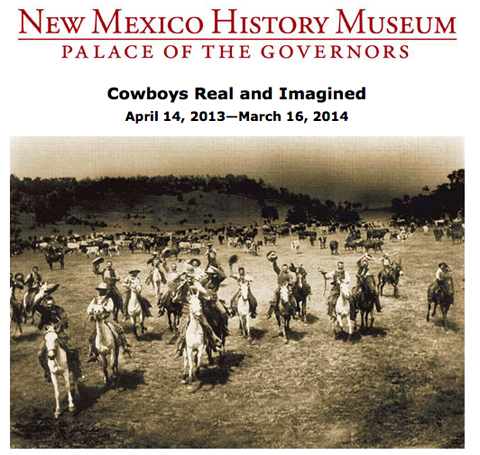
Santa Fe (Feb. 20, 2013)—When America needed hard workers, the cowboy was there. The job was dirty and difficult, low-paid and lowly regarded. But when an America torn by the Civil War needed a hero to unite its soul, the unassuming cowboy was an unlikely—and ultimately lasting—pick.
Since riding out of Spanish horse culture, he’s been an itinerant hired hand, an outlaw, a movie star, a rodeo athlete, a radio yodeler, and a rhinestoned disco diva. He’s been Spanish, Mexican, African American, Anglo, male, female, straight, and gay. His image has been co-opted to sell trucks, beer, boots, beans, jeans, tires, cigarettes, leather couches, presidential candidates, and a lifestyle far beyond the means of real-life buckaroos.
Despite the sometimes tortured lengths our imaginations have taken cowboys and cowgirls, the basic fact of their life is this: a rough-hewn job stacked against steep odds. The daily dangers of working with cattle and horses are matched by volatile global markets, a public with fickle tastes in heroes, and a big sky that can deliver glorious sunshine as easily as tornadoes, droughts and snowstorms.
Today, real cowboys sit uneasily in the saddle (or on the seat of an ATV, occasionally dubbed “a Japanese cutting horse”). Climate change has altered the range and dealt cattle-ranching a potential kill card. Even as popular culture delivers new-and-improved versions of a fanciful life on the range, Cowboys Real and Imagined asks a bare-boned question: Will the people who tamed that range survive?
Using artifacts and photographs from its wide-ranging collections, along with loans from more than 100 people and museums, Cowboys Real and Imagined (April 14, 2013, through March 16, 2014) blends a chronological history of Southwestern cowboys with the rise of a manufactured mystique as at home on city streets as it is in a stockyard.
Augmented by archival footage, oral histories, musical performances, and a programming series that includes showings of classic Western movies filmed in New Mexico, the exhibition anchors the cowboy story in the Land of Enchantment, a place that helped give birth to the real thing and, due to geographical and economical factors, held onto it longer than most other states.
“One of the reasons the cowboy myth has been so pervasive and long-lasting is because anybody could become a cowboy of sorts,” said guest curator by B. Byron Price, director of the Charles M. Russell Center for the Study of Art of the American West at the University of Oklahoma and director of the University of Oklahoma Press. “It isn’t always what you wear, who you are, or what your attitude is. The exhibit asks: Who is a real cowboy?”
In its search for an answer, Price said, the exhibit discovers that cowboy “is a verb, an adjective, a noun, an adverb.”
Despite a career devoted to exploring the story of the cowboy, Price said he was amazed at what he found in the museum’s Palace of the Governors Photo Archives, including a small cache of glass-plate negatives. Made by Ella Wormser, the wife of a Jewish merchant, they may be the only visual evidence of trail drives making the transition toward rail transport.
“I went crazy when I found (those),” he said. “She was the wife of a mercantile owner who came to Deming in 1895 and developed an interest in photography. Most significantly, she shot a series of images that followed a roundup near Deming and driven to a railhead through a process of chutes. You cannot imagine how rare this series is. … In one of them, you can see her skirt in shadow, along with the tripod and camera.
“I’ve spent years studying this and I haven’t found any better material than here at the New Mexico History Museum. In New Mexico, because the old style of cowboying still prevails, that attracts photographers—contemporary photographers.”
Modern-day shooters represented in the exhibit include Barbara Van Cleve, Lee Marmon, Donald Woodman, and Herbert A. Lotz. Other artifacts include cowboy clothing from the 1700s through contemporary times; the chuck wagon that fed cattle-driving cowboys of northeastern New Mexico’s famed Bell Ranch; ephemera from the dude ranches that once speckled the state; and the ads that banked on cowboys to sell products. People who pop up through the exhibit include legendary Lea County cowgirl and rancher Fern Sawyer; singer Louise Massey; actor and film producer Tom Mix; Buck Taylor, “The King of the Cowboys”; Billy the Kid; artist Frederic Remington; Gila River cowboy, trapper and guide Quentin Hulse; and the anonymous Rough Riders, cowboys, and vaqueros whose real-life acts still occupy a wide-open space of the American dream.
As part of the exhibit, the Palace Press is preparing a fine-press version of Jack Thorp’s classic Songs of the Cowboys, first published in 1908 in Estancia, NM, on a press now used at the History Museum. Thorp’s was a pioneering compilation of songs he heard hummed and strummed around campfires in New Mexico and included tunes from African American cowboys. Most of what he recorded likely would have faded into the starry skies without his effort.
Also at the museum: Tall Tales of the Wild West: The Stories of Karl May recounts the life of a German author who conjured a cowboys-and-Indians world that has resonated in Europe for over a century. In the Mezzanine Gallery through Feb. 9, 2014.
Download a bounty of high-resolution images by clicking HERE.
